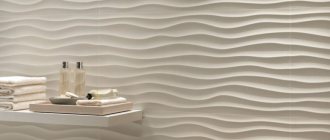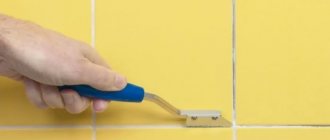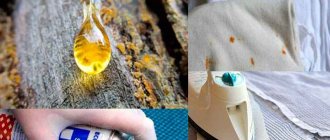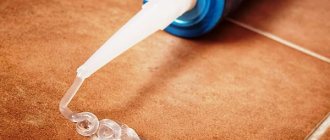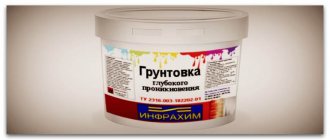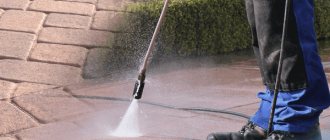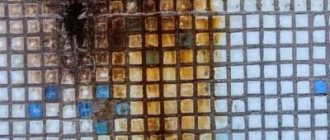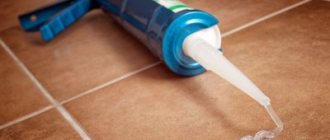Grouting the joints at the joints of the laid tiles is the final stage of the cladding work.
It may be necessary to remove grout for various reasons. This includes lack of accuracy in applying the product, the need to remove the old layer, and restoration.
When starting work, it is necessary to take into account the condition of the grout, its type, as well as the characteristics of the tile itself.
We will tell you in this article how and with what you can remove grout from tiles.
Safe products and tools
You can clean the grout material from the floor and walls with a scraper, brush or pumice stone. This is a monotonous and difficult way to get rid of dried fugue. It takes a lot of time and effort, but the risk of damage to the tile coating is minimized.
Before you wash the grout off the tiles, try to initially remove dirt in a small area with a scraper or brush. Decide which tool is more convenient to work with. For best results, wet the stains and, with some effort, remove them.
Safe chemistry
You can clean the tiles from the fugue after repair by using special chemical liquids for cleaning ceramics from mortars. As a rule, these are acid preparations to destroy the remains of epoxy or cement fugue. Before starting work, you need to test the detergent on a small, inconspicuous area. It is also recommended to protect all surfaces made of synthetic materials, such as PVC, acrylic, etc.
Choose products from well-known manufacturers, read the composition and pay attention to what type of fugue the product is intended for.
Liquids for cleaning cement and epoxy deposits:
- Prosept Cement Cleaner. Concentrated liquid effectively removes old stains and stains. Before washing the grout from smooth and embossed Marvel Dream tiles, the detergent must be diluted with water 1:5. Spray the liquid onto the work surface with a spray bottle. After ten minutes, remove the residue with a damp sponge or lint cloth. Afterwards, thoroughly wash the surface with clean water 1-2 times.
- Atlas Szop. Cement residue cleaner. The liquid effectively removes both fresh and old cement stains on the ceramic surface. The cleaner is not recommended for use on substrates that are unstable to its influence, for example, marble. Depending on the contamination, it should be diluted with water. To remove stains and deposits of cement fugue, the ratio of water and product will be 1:3; for old large stains there is no need to dilute it. Apply the solution to the stains with a sponge. Leave for 10 minutes and then remove any remaining residue. Rinse the surface thoroughly with clean water.
- Litokol Litonet Pro. Liquid cleaner for epoxy fugue residues. The jelly-like product removes marks and stains from ceramics of various textures and shapes. It even copes with dried dirt on the walls without running down. The cleaner does not need to be diluted. The product must be distributed evenly over the entire surface. Wait 25 minutes and remove with any remaining grout. Once cleaning is complete, rinse the tiles with clean water again.
- Clean Kiilto. Acidic liquid for removing building cement mortars. Before applying the cleaning product, you need to moisten the stains with water. Then use a sponge with solvent to treat all stains. Wait 20 minutes and clean the surface. Using a hard plastic brush can speed up the removal of dirt.
- Keranet Mapei. Acidic product for removing cement grout from tiles. Available in the form of a solution and concentrated powder. The main component is organic acid. Removes traces of cement mortar and does not damage the joints between tiles.
- Unicum. The concentrated product is intended for removing fugue and putty. It must be applied evenly and spread with a sponge onto the stain. After 20 minutes, wipe with a cloth and wash the surface of the cladding with water.
- Starwax. Cement based grout remover. Effectively removes old and stubborn dirt. The solution does not need to be diluted with water. It is necessary to apply the product to stains or stains, wait 15 minutes and use a plastic brush to remove the remaining fugue. Afterwards, rinse everything off with clean water and wipe the surface dry with a cloth.
If synthetic detergents come into contact with the skin or mucous membranes, rinse the affected areas with plenty of water.
During work, it is necessary to ventilate the room more often.
Folk remedies
If you don’t have special materials at hand, you can wipe off the dried grout and remove stains using folk remedies:
- Soda + vinegar. You need to mix vinegar and soda in equal proportions, apply it to the remaining grout materials and use a stiff plastic brush to clean the tiles in a circular motion. This method is suitable for cleaning smooth and embossed decorative tiles.
- Glycerol. Glycerin is diluted with clean water in a ratio of 1:4 and the resulting solution is used to treat stains and stains from grout. Afterwards, carefully clean off the cement composition with a sponge or stiff brush. The cleaned surface must be rinsed with water and wiped dry.
- White Spirit. You need to dissolve 1 tablespoon of white spirit in a glass of water and treat the stains. Afterwards, thoroughly clean the residue from the fugue and rinse with water.
- Hydrochloric acid. You need to prepare a solution in a 1:1 ratio. Using a stiff brush, apply to the grout and remove all dirt. Then moisten the sponge with water and clean the places where the acid was used. If necessary, you can rinse the tiles with water again.
- Ammonia. The product is suitable for removing minor stains from cement fugue. Before doing this, you can generously moisten stains and stains with water. After 2 tablespoons of ammonia, dilute with a glass of water and wipe the contaminated areas.
Before you wash the tiles from grout using folk remedies, you should first wet the stains with water. Unfortunately, they are not effective enough to remove dried grout. In the case of contamination from epoxy fugue, folk remedies will not help.
Prohibitions when deleting
When removing grout, it is important to remember a number of prohibitions:
- You cannot use purchased solvents that are not intended for removing grout from tiles, as ignoring this point can lead to damage to the surface.
- You cannot begin general cleaning of the surface until the grout has completely dried and the main contaminants have been removed. Violating this rule may result in damage to the compound between the tiles.
- You should not use solvents, even homemade ones, with your bare hands. Rubber gloves are a necessary means of protection.
- Do not use a metal scraper or knife to clean directly on the tiles. Such a tool can leave damage not only on a glossy surface, but also on a matte and embossed one.
How to care for tiles
In order for the coating to last for a long time, you need to know how to properly care for tiles.
For glossy structures, strong acid-based detergents should not be used. This may damage the gaps and seams between the products.
It is best to purchase special products for tiles, ceramic tiles and porcelain tiles.
Do not use metal brushes or abrasive powders because they will severely scratch the surface of the coating. This is especially noticeable on glossy ceramic tiles.
The Best Tile Cleaners
To ensure that the tiles retain their attractive appearance for a long time and do not fade, it is better to use specialized mild detergents:
- Mister Muscle. Eliminates plaque, rust, removes stains from the surface of tiles and gives it shine. It is necessary to apply the liquid to the dirt, wait 3-5 minutes and walk again with a damp sponge. It copes well with old, stubborn stains and does not run off vertical surfaces. In this case, there is no need to scrape and rub the plaque with a washcloth. The detergent perfectly removes even formed mold from the grout.
- Frosch. Suitable for most types of tiles. Effectively removes dirt, grease, stains and plaque from ceramic tiles. Frosch is harmless to the body. The product neutralizes unpleasant odors and kills germs. To clean the tiles from dirt, dilute 2 caps of detergent in 5 liters of water and clean the surface. Not intended for use in its pure form.
- Cif Anti-plaque. Removes accumulated dirt thanks to a unique water- and dirt-repellent formula. In a matter of seconds it will remove limescale and soap stains from the surface of the tile. SIF should be applied evenly to the dirt, wait 5 minutes and rinse with clean water.
- Domestos. Effectively eliminates fungus, whitens grout joints between tiles and disinfects. Directions for use: Dilute 2 caps of gel in a five-liter bucket of water and remove dirt with a sponge or soft-bristled brush. Then rinse the surface with water and wipe dry.
- San-klin (Santik). Liquid for removing limescale, rust and other contaminants from tiles. It must be applied to the surface for 5-10 minutes and then remove any remaining dirt.
You can also use the following aids to clean tiles:
- Bleaching powder. Dilute the powder with clean water. Pour the solution into a spray bottle and spray it onto the desired surface. Then leave for five minutes and rinse with plenty of clean water. Let the ceramics dry or wipe the surface with a dry cloth. Chlorine solution kills germs and gets rid of mold.
- Melamine sponge. Easily wipes off minor stains, removes limescale and does not spoil the appearance of the cladding. You just need to wet the sponge and rub away the dirt.
- Steam cleaner. A gentle alternative to aggressive cleaning liquids. Steam cleans the tile surface no worse than chemicals. And at the same time it does not have any mechanical effect. Steam supplied under high pressure dilutes grease stains on the tiles and disinfects the surface being cleaned, killing germs. The steam cleaner is excellent at removing mold and limescale in the bathroom. It easily removes even greasy stains in the kitchen.
To prevent ceramics from fading and scratches appearing on it during use, you need to treat it with a special varnish. A durable protective coating is created, the color does not change for many years, and caring for the tile surface is greatly simplified because almost no dirt accumulates on the varnish coating.
With proper cleaning and good timely care, ceramic tiles will last for many years.
Recommended cleaning times
Removal of the grout layer is carried out in several stages - from the initial removal of excess to dry and wet cleaning. It is better to carry out the first stage when the material has not yet hardened, but has already hardened sufficiently. In this case, the risks of damaging the surface of the tile and disrupting the hardening process of the putty are minimized.
It’s easy to check the condition of the seams - just moisten them with a damp cloth and evaluate the reaction.
If, after interacting with the liquid, the grout mass begins to increase in size and extend beyond the seam, it is too early to begin cosmetic work. If the layer remains unchanged and does not react to water in any way, then the moment for cleaning is most suitable.
Reference! The average initial setting time for tile grout is about 30 minutes.
Cleaning methods
To grout the joints between tiles, various materials are used, which can be wiped off with certain substances. When cleaning after renovation, you should know what type of grout was used for finishing work.
For cement grout
Cement paste is most often used for finishing tile joints. Fresh cement can be cleaned from tiles by treating with warm water and wiping the surface with a sponge. When the mass has time to harden, it is necessary to apply more radical methods.
Acidic solutions
After contact with the surface, highly active acid-containing solutions begin to soften the cement grout. Among such solutions you can use:
- A liquid concentrate that is suitable for any type of tile and fills uneven surfaces, simplifying the work process.
- Powder product to be diluted. This option is not applicable to porous and marble surfaces.
Highly concentrated acid-containing solutions must be used according to the attached instructions. To be on the safe side, it is recommended to test the product on a small area to first ensure a safe result and no negative consequences.
Liquid for eliminating whitewash
This substance is intended to effectively remove plaque, traces of cement and other building materials. The liquid is diluted with water and applied to the tile joints using a brush, roller or spray.
After waiting a few minutes, wipe the surface with a sponge with a not too hard surface or a rag.
Special removal of cement deposits
A specially developed cement paste remover is widely used after finishing and repair work in residential buildings and in production. The composition not only helps to remove grout, but also concrete splashes, tile adhesive and other types of contaminants. The solution can be used indoors and outdoors. The action of the wash is 2-3 minutes; a sponge or spray bottle is used for application.
Based on epoxy resins
Solutions for epoxy residues are used to clean tiles from streaks, stains and other contaminants that have arisen after working with grout and other materials based on epoxy resins.
Special cleaning solution
A two-component remover, most often available in spray form, it removes stains within 12 hours of application. The cleaning solution has the following advantages:
- removes epoxy residues after a single treatment;
- does not leave streaks on the tiles;
- dissipates quickly after use.
Mechanical impact
Dried grout cannot always be washed off using various solutions, so additional mechanical action is required. In most cases, treating with a sponge with a rough surface helps. It is important not to damage the tiles during work.
Fresh
You can remove fresh grout from a ceramic or glass surface using a standard remover spray. The substance can be used immediately after installing the tiles or after grouting work.
conclusions
During repairs, take measures to protect the fresh cladding from the ingress of building mixtures. Use cellophane and masking tape. This way you will reduce the amount of dirt and reduce the amount of work you have to do to clean up fugue marks. As you can see, there are different ways to remove traces of tile grout from tiles. It is important to immediately determine what type of grout you are dealing with and what surface of the tile. Based on this, they decide whether to immediately begin removing dirt or whether to wait time. Before cleaning, it is better to follow the rules listed here. To remove cement grout, improvised means such as vinegar, soda and citric acid are suitable. Epoxy fugue, as it is more resistant, is removed immediately with a special solvent or acid with a reagent. Follow the listed instructions and after the repair you will be able to effectively remove all remaining dirt from the tile finish without harming the coating itself.
Cleaning steps for cement grout at home
To properly clean after renovation, you need to follow several steps step by step. Following simple instructions will allow you to achieve the best results with minimal effort.
Preparation
Before actually performing work, you should wear personal protective equipment, including rubber gloves, goggles and a respirator if caustic substances are used.
You should also open a window in the room. If work is being done in the bathroom, you can turn on the water in the bath.
Application of the solution
The solution is applied to all excess stains that remained on the surface of the tile after finishing. For spot application of the solution, it is better to use a brush.
Scrubbing away dirt
After treating the dirt, you should wait 5-10 minutes for the active substance to begin to interact with the grout. Then wash off the softened solution in a circular motion. If the stains are not removed on the first try, you will need to clean the tiles again.
How to wash off
It is enough to wipe off the remaining remover from the surface with a sponge soaked in water. Even a small amount of an acid-containing solution can corrode the cement and the tile itself, so it is important to remove the substance completely.
Traditional methods
In addition to using special-purpose tools, you can resort to folk methods. In practice, several options have become widespread that help quickly wash away traces of putty on the tiles. Most folk methods can be used using various improvised means.
Tile floor cleaner
The floor tile cleaner contains acidic components that help remove cement stains. To clean, you need to distribute the solution on the dirty area, wait 15 minutes and remove the residue with a brush.
Limescale remover
It is recommended to use a product that dissolves lime deposits when treating floor tiles after repair work. The substance is rubbed into the relief surface with a brush.
White Spirit
The solvent used in various fields is alcohol spirit, which contains hydrocarbons obtained by processing petroleum products. Cleaning with this solvent makes it easy to remove stains from porcelain tiles and similar surfaces. For processing, you need to stir 1 tablespoon of the substance in a glass of warm water.
Glycerol
Glycerin does not contain caustic components that can damage tiles, so the substance can be used to clean any surface. To remove streaks and stains, you should prepare a mixture of glycerin and water in a ratio of 1:3.
Ammonia solution
A solution of ammonia (ammonia) removes even stubborn dirt on the tiles. To ensure that there are no streaks left on the tiles after treatment, it is recommended to prepare the mixture by adding a tablespoon of solution to 1 liter of water. The resulting substance is sprayed onto the tiles or covered with a brush.
Lemon acid
The use of citric acid allows you to remove traces of cement grout, glue, lime deposits and other substances. To clean the tiles you need:
- put on protective gloves and immerse the brush in the acid;
- wipe contaminated areas on the tiles without getting on the seams;
- carry out treatment until the stains are completely eliminated.
Soda and vinegar
To prepare the cleaning product, you can mix baking soda and vinegar in proportions of 2 and 3 tablespoons, respectively. The mixture softens traces of cement and cleans even textured surfaces. The solution must be applied to the stains and wiped with a brush after 10 minutes. For best results, you can use soda ash rather than baking soda.
Abrasive sponge
Sponges for cleaning tiles are a special type of foam rubber or polyurethane foam, on which there is an elastic film with an abrasive. Different types of sponges differ in the number of abrasive grains. Depending on the type of surface being treated, it is worth choosing a harder or softer sponge.
Why do you have to remove the sealant?
When tiles are laid on a wall or floor, a small space is left between adjacent elements. This distance helps to evenly distribute the load on the surface, helping to preserve the coating. The seams between the tiles need to be sealed and at the same time give an attractive appearance to the surface. To do this, they are carefully filled with fugue, a mineral or polymer mixture of a suitable color.
Sometimes it gets on the tiles, and removing the frozen mass from the tile surface is a separate task. But more often you have to think about how to remove old grout from tile joints, and this question arises after prolonged use. The deterioration is manifested externally: the seams crack, change color, and darken due to mold. The causes of wear are the following:
- The grouting composition was chosen incorrectly, without taking into account the purpose of the room. For example, the kitchen and bathroom differ in temperature and humidity conditions, and accordingly, different compositions are needed.
Grout loses its appearance for many reasons Source rndtech.de
- The solution was prepared without regard to the instructions. The manufacturer always indicates the proportions and explains what the consistency should be. Manufacturing “by eye” will reduce the strength and, as a result, the durability of the seams.
- The work was done poorly. The sealant was applied carelessly, with omissions or not completely filling the volume.
- The tiled surface was not properly maintained. Some household chemicals (containing acid) corrode the grout.
- Violation of ventilation. Poor air exchange in a humid room inevitably gives impetus to the development of mold, and it, first of all, happily inhabits the joints of the seams.
- Sometimes the grout color is chosen poorly. For example, light-colored seams on the floor sooner or later lose their appearance and quality due to constant contamination.
Cleaning with a construction knife Source immo.vlan.be
How to remove epoxy resin
Epoxy resin dries completely within a day and is invulnerable to the effects of acid-base compounds. It is possible to remove traces of epoxy resin only with the help of highly active reagents. When using cleaners, you must follow a number of rules and properly prepare for the work. Read more here.
Preparation
The first preparatory step is to select and purchase a special softener that can remove epoxy resin residues. To complete the work, you also need to prepare a metal brush for processing the ribbed surface, protective gloves and a respirator.
Seam sealing
To prevent the cleaner from destroying the tile seams, it is necessary to close them while the stains are being washed off. Applying a thick layer of masking tape creates an obstacle for the solvent to pass to the seams. If the solution gets on the seam, you must immediately wipe it off with a rag or sponge.
Solvent
If the epoxy resin has dried, you need to treat it with a solvent and wait 10 minutes for it to soften. Then traces of grout are removed with a metal brush or scraper. When performing work, it is important to be careful and control the degree of pressure so as not to destroy the tiles or leave scratches on the surface.
Types of mixture
Cleaning will depend on the type of grout. Each type has its own cleaning mixtures. For example, epoxy is more difficult to clean; it has improved characteristics and is resistant to chemical agents and moisture. It requires professional solutions.
Features of different grouting compounds:
- Cement - used for most types of tiles, it is convenient to work with, it is purchased in the form of a dry mixture. Various components can also be added to it to improve performance. Fugues based on Portland cement and sand are used for grouting joints no larger than 5 mm, but they are not at all suitable for ceramic coatings. Sand can damage the smooth surface of the tiles.
- Epoxy is a two-component product that is mixed before work; it is significantly superior to cement compositions due to its increased strength and moisture resistance. However, such grouting is used more often at production facilities; for home work it is complex and requires special skills. Removing epoxy grout is not an easy process. The material sets quickly, becoming very durable.
- Silicone - it is easiest to scrub using brushes and water, it is not very durable, it is easy to damage, so it is often used in combination with other grouts. The advantage will be a wide palette of colors.
How to remove fugu
You can remove the old layer of grout between the tiles using a paint knife. The principle of removing the fugue is to carefully run a knife along the seam several times without touching the edges. The pressure of the knife will cause most of the grout to fall out, after which you will have to dig out the remains. Instead of a knife, you can use a grinder, but this tool is best used only if you have practical experience. The need to remove the fugue arises when applying new grout.
Homemade solutions
The total area of tiled finishing can be more than 50 square meters. m. To treat such an area, it is necessary to purchase a large volume of solvents, which contributes to additional costs.
You can replace professional products with homemade analogues:
- 20% solution based on laundry soap - suitable for removing cement and polyurethane;
- 10% acetone solution - effective for dissolving epoxy resin;
- A 10% dishwasher solution (chlorine-free) is useful for removing polyurethane.
Solutions containing acetone release volatile substances. Therefore, it is recommended to work with them wearing a mask and glasses. Also, when removing grout, the room must be ventilated.
Recommendations from experts
Remember, old hardened grout must be removed carefully so as not to damage the front surface of the tile. This can be done either mechanically or chemically, but it is important to choose the right compositions.
For example, substances based on organic acids can be used to remove cement fugues. To combat silicone joint fillers, acidic substances are also used, which soften the composition, making it mushy.
It is important that when removing any type of grout, you must first take care of your own safety and use at least gloves and a mask, because acid preparations have a negative effect on the human body.
Treating cracks with steam and covering with a masking compound
In addition to chemical and mechanical methods of removing sealant from the joint between tiles, you can use hot steam. The fact is that silicone usually withstands temperatures up to 90 degrees, and steam is much hotter, so it has a destructive effect on sealants and effectively removes it.
In such a situation, you need to work as follows:
- Direct the steam stream to the area to be treated and hold for a few seconds. During this time, the sealant literally peels off from the base.
- Afterwards, using a hard-bristled brush and water, the material is removed from the seam with vigorous movements. Typically, exposure to a concentrated jet of steam occurs simultaneously with mechanical removal of the sealant, that is, special brushes are used.
If the place needs to be restored without removing the old grout, then cover it with a special pencil with a waterproof filler or cover it with a water-based composition.
Cleaning fresh grout
Modern grout hardens within 24 hours, so it is easiest to clean it immediately after filling the tile joints. But first, after processing, it is necessary to check the seams for stability. Lightly moisten them and observe the reaction. If no changes appear, you can begin to wash away the dirt.
To do this, lightly wet a soft sponge in water and carefully wipe the tile joints to remove dirt. When removing excess mortar from facing tiles, do not wet the sponge excessively - this can lead to distortion of the seams
If you missed the moment, the cleaned joint has dried out slightly, and white marks appear on the tiles, it is recommended to resort to the following cleaning measures:
- White stains can be washed off well with special felt graters using regular dishwashing detergent or vinegar solution (add 100 grams of vinegar per 2 liters of water).
- Baking soda will help remove grout marks. Apply a little soda to the slightly moistened surface of the tile and begin the scrubbing process in a circular motion.
- A felt grater soaked in vegetable oil will help in the fight against dirt on embossed tiles.
Preventive actions
To avoid the need to get rid of the grout remaining on the surface of the ceramic tiles after repairs, it is better to take preventive measures to prevent the grout from getting on the cladding. There are not many of them, some of them are labor-intensive, but sometimes, especially in the case of epoxy grout, it is easier to prevent its appearance than to deal with dried residues.
One of the most effective methods is the use of protective foam, which is used to cover the tiles, and upon completion of work, wash it off along with the remains of the dried fugue.
Masking tape will also help. It needs to be used to cover the entire perimeter of the tile, leaving only the spaces for the fugue free. This process is labor-intensive, but also effective.
The most important preventive measure is considered to be compliance with the technology of stage-by-stage jointing of one area after another and thorough cleaning of the composition remaining on the ceramic tiles. It’s better if the process takes a long time, but after it you won’t have to clean the tiles of grout residue using chemicals that are harmful to health.
Tips for carrying out work
Removing the joint mixture is not very difficult, but it is a labor-intensive task. It can be significantly easier if you follow simple recommendations.
- The process of opening the seams is accompanied by copious dust. Furniture, household appliances, etc. should be removed from the premises.
- The room should be well ventilated, especially if chemical reagents will be used.
- Acid solvents should not be used when working with marble and porcelain tiles.
- To find out if there is mold on a material, you can use hydrogen peroxide. It is also used to bleach darkened jointing compound.
Getting rid of old grout is not very easy, but you can do it if you want. You must be patient and carefully perform all labor-intensive operations. Then the tile will remain unharmed and can be rubbed with a new compound.
Pollution prevention
In order not to think about how to get rid of dried stains, it is better to take preventive measures and prevent their appearance, since in some cases it can be very difficult to remove dry grout and primer.
To do this, it is necessary to protect in advance all surfaces treated with these solutions from accidental drops of the mixture. When grouting the seams, cover your ceramic tiles with masking tape or cling film in advance. When working with a primer solution, be sure to cover the floor and other surfaces that fall into the risk zone with construction protective film, and seal all joints with tape. This way you will completely protect yourself from the composition flowing and leaving unnecessary traces.
If it was still not possible to avoid trouble and somewhere in the end a stain from the grout or primer appeared, it is better not to delay time and act immediately. Wipe the stain immediately with a wet rag moistened with warm water - this will save you from further red tape in cleaning the tiles.
Tip: always treat tiles for stains starting from the bottom and working your way up, and wipe dry in the opposite direction.
We hope that our simple and effective tips helped you cope with the problem of grout staining your tiles, and your home will only shine clean and white!
